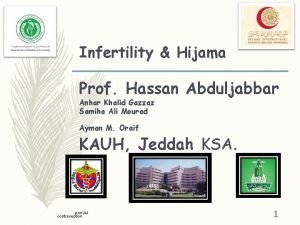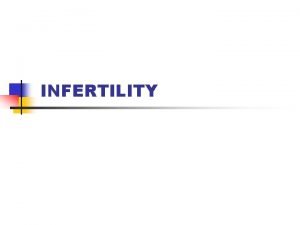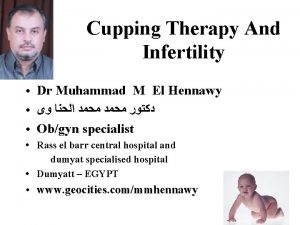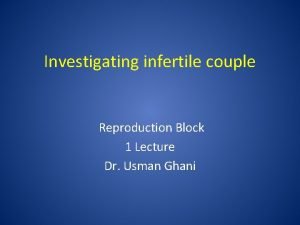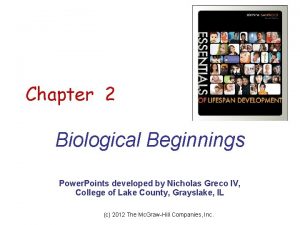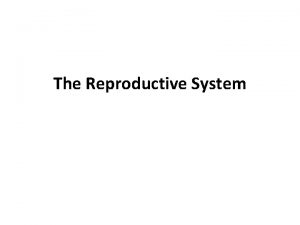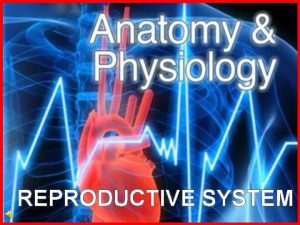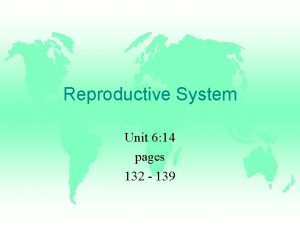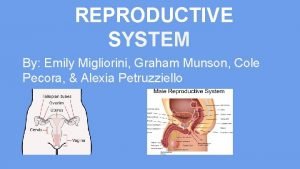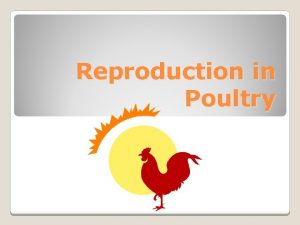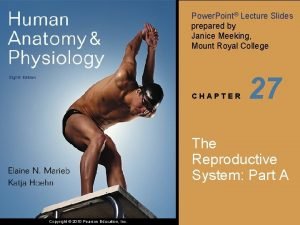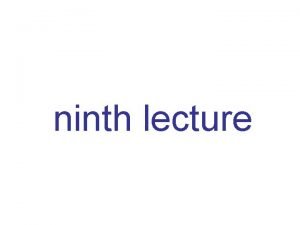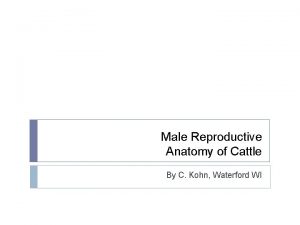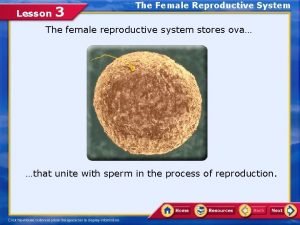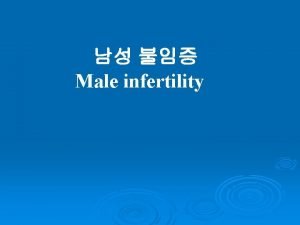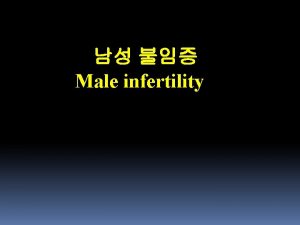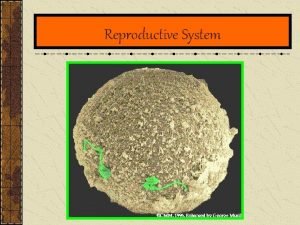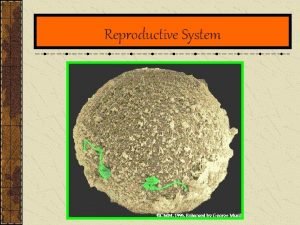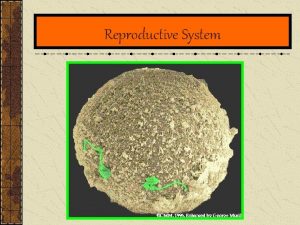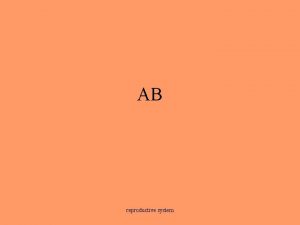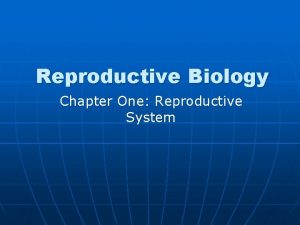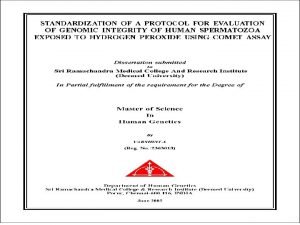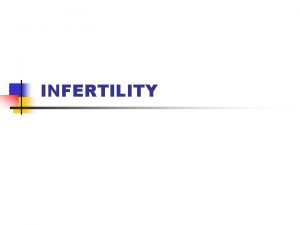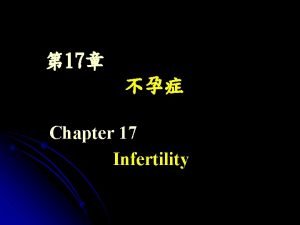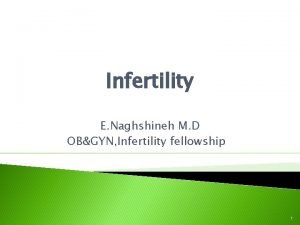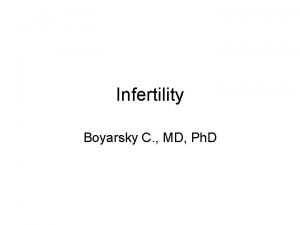Infertility is a disease of the reproductive system


































- Slides: 34



� Infertility is “a disease of the reproductive system defined by the failure to achieve a clinical pregnancy after 12 months or more of regular unprotected sexual intercourse. ”… (WHO) � Subfertility: less fertile than a typical couple.

Primary infertility Couple Has Never conceived a child. - Secondary infertility Woman has previously been pregnant, regardless of the outcome, and now is unable to conceive


� OVULATION PROBLEMS � TUBAL BLOCKAGE � MALE ASSOCIATED INFERTILITY � AGE RELATED FACTORS � UTERINE PROBLEMS � PREVIOUS TUBAL LIGATION � PREVIOUS VASECTOMY � UNEXPLAINED INFERTILITY

� ROBERTSONIAN TRANSLOCATION(Robertsonian translocation (ROB) is a rare form of chromosomal rearrangement that in humans occurs in the five chromosome pairs, namely 13, 14, 15, 21, and 22. � General factors like DM, Thyroid disorders � Hypothalamic factors � Environmental factors. --chemicals, pesticides etc

� Kallmans syndrome: causes male hypogonadism because of hypothalamo gonado tropin releasing hormone(Gn. RH). …it will results in delay in pubertal development. � Prader-willi Syndrome: a rare congenital disorder characterized by learning difficulties, growth abnormalities, and obsessive eating, caused especially by the absence of certain genes normally present on the copy of chromosome 15 inherited from the father.

� The Bardet–Biedl syndrome (BBS) is a human genetic disorder that produces many effects and affects many body systems. It is characterized principally by obesity, retinitis pigmentosa, polydactyly, hypogonadism, and renal failure in some cases.

� Sickle cell anemia: a severe hereditary form of anaemia in which a mutated form of haemoglobin distorts the red blood cells into a crescent shape. Beta thalassemia (β thalassemias) are a group of inherited blood disorders. They are caused by reduced or absent synthesis of the beta chains of hemoglobin that result in variable outcomes ranging from severe anemia to clinically asymptomatic individuals.

cerebellar ataxia (ACA): The cerebellum is the area of the brain responsible for controlling muscle coordination. If it becomes inflamed or damaged, suddenly lose coordination. This is called acute cerebellar ataxia (ACA), or cerebellitis.

� Klinefelter's syndrome — This syndrome involves the presence of abnormal sex chromosomes. A male normally has one X chromosome and one Y chromosome. The Y chromosome contains the genetic material with the codes that determine the male gender, and related masculine characteristics and development. Males with Klinefelter's syndrome have an extra X chromosome, which causes abnormal development of the testicles.

� XYY syndrome is a genetic condition in which a human male has an extra male (Y) chromosome, giving a total of 47 chromosomes instead of the more usual 46. This produces a 47, XYY karyotype, which occurs every 1 in 1, 000 male births.

� XX male syndrome: A syndrome characterized by the presence of an XX sex chromosome complement in an individual with male genitalia including both testes but no sperm production (azoospermia).

� Karyotype is normal 46, but the men shows dysmorphic features like webbed neck, short stature, low set ears etc…. . at birth 75% will have cryptochidism that results in infertility. if testes is fully descended then fertility is posible.

� Immotile cilia syndrome, is a rare, autosomal recessive genetic disorder that causes a defect in the action of the cilia lining the respiratory tract and fallopian tube, and also of the flagella of sperm in males.

� Zero sperm count

Post testicular portion of the reproductive tract includes epididymis, vas deferens, seminal vesicles, and associated ejaculatory organs. conditions include… 1. Wolfian duct abnormalities--- absent of epididymis, vas deferns etc. 2. Congenital absence of vas deferens 3. Youngs syndrome: is a rare condition that encompasses a combination of syndromes such as bronchiectasis, rhinosinusitis and reduced fertility.

� Epididymal obstruction. � Myotonic dystrophy: is characterized by progressive muscle wasting and weakness. � Adult polycystic kidney diseases

� Detailed fertility history � Physical examination: testicular or reproductive examination � post ejaculatory urine sample � Semen analysis � Blood tests � Post coital test � sperm antibody test � Testicular biopsy � Ultra sound � Fertilization test � PGD

� Vitamin A and Vitamin C diet � Hormonal monitoring and ovulation period intercourse � Advice for life style changes— avoid smoking, drugs and increased use of coffee rest and exercises prevent overheating of testes.

� Sperm introduced into female reproductive tract by means other than coitus � sperm can come from donor / sperm bank or from husband � often used when male has low sperm count or antibodies present in ejaculate


� 1 st performed in 1978 (Louise Joy Brown) � often performed on infertile women with tubal blockage � Sperm and egg combined in the lab, fertilization � Zygote placed back into the uterus � Very expensive and not always successful � Oldest woman in the US to give birth using in vitro was 62 years old an Romanian woman gave birth at 66


� The procedure involves a single sperm carefully injected into the center of an egg using micro needle.


� GIFT = gamete intrafallopian transfer


� Invitro maturation: In this process follicles are harvested a few days before ovulation. Maature embryo is transferred. � Embryo transfer: 5 days old embryo are transfering.


� Egg donation is when eggs from a donor are fertilised with your partner's sperm in a laboratory dish. The resulting embryos are then transferred to your uterus.

Woman unable to have children may have IVF in another woman who has the child

� ADOPTION
 Cupping points
Cupping points Infertility definition
Infertility definition Hijama for infertility
Hijama for infertility Female infertility
Female infertility Sherman j. silber
Sherman j. silber Cystic fibrosis male infertility
Cystic fibrosis male infertility Communicable disease and non communicable disease
Communicable disease and non communicable disease Female anatomy labeled
Female anatomy labeled Endocrine system and reproductive system
Endocrine system and reproductive system Function of vagina
Function of vagina Fungsi bagian yang ditunjuk oleh huruf p adalah
Fungsi bagian yang ditunjuk oleh huruf p adalah Seminal tubules
Seminal tubules Female reproductive system with baby
Female reproductive system with baby Ovarian ligament.
Ovarian ligament. Anatomy of the reproductive system exercise 42
Anatomy of the reproductive system exercise 42 Female anatomy
Female anatomy Oogenesis diagram
Oogenesis diagram Female reproductive system pregnancy
Female reproductive system pregnancy Epidiymitis
Epidiymitis Pearson
Pearson Reproductive system jeopardy
Reproductive system jeopardy Parts of male and female reproductive system
Parts of male and female reproductive system Figure 16-1 male reproductive system
Figure 16-1 male reproductive system What is reproductive system
What is reproductive system Reproductive physiology
Reproductive physiology Poultry reproductive system
Poultry reproductive system Plants reproductive system
Plants reproductive system Art-labeling activity: the male reproductive system, part 1
Art-labeling activity: the male reproductive system, part 1 Objectives of poultry production
Objectives of poultry production Male reproductive system information
Male reproductive system information Where semen is stored
Where semen is stored Male reproductive system
Male reproductive system Seminal duct
Seminal duct Lesson 3 the female reproductive system
Lesson 3 the female reproductive system Asexual reproduction
Asexual reproduction
